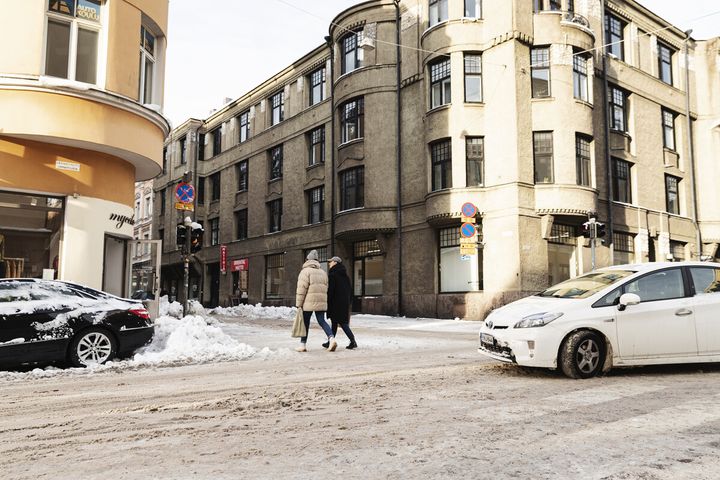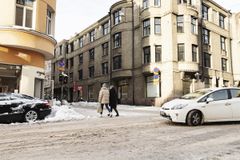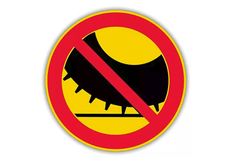Helsinki bans studded tyres on Lönnrotinkatu street

The ban on studded tyres on Lönnrotinkatu will apply to the 900-metre section between Mannerheimintie and Hietalahdenkatu streets. The one-way Lönnrotinkatu street runs west from the city centre, serving drivers travelling from Pohjoisesplanadi towards the Ruoholahti district and to the Kamppi and Punavuori districts.
A new traffic sign that prohibits passage while using studded tyres, in accordance with the new Road Traffic Act, will be tested on Lönnrotinkatu until autumn 2025. The pilot aims to study the impact of the studded tyre ban on air quality and the popularity of friction tyres. At the same time, the City will assess the ban’s consequences, compliance rate and suitability.
The ban will bring in new traffic signs and monitoring devices placed along the street. The devices monitor both air quality and the use of studded tyres.
Driveways accessible even with studded tyres
The sign that bans studded tyres still allows cars with studded tyres to access the plots along the street.
The alternative route to Ruoholahti will be about 300 metres longer and traverse Mannerheimintie and Pohjoinen Rautatiekatu. The alternative route to Kamppi and Punavuori will be Bulevardi, which will make the trip about 200 metres longer.
The ban is assessed to have a low impact on the businesses operating on Lönnrotinkatu and its vicinity, and their accessibility by car. The effects of the ban will be assessed during the pilot, and as such, the arrangements can be changed as necessary.
The choice of tyres affects air quality
The air quality in Helsinki is generally good. However, on busy streets, the particulate matter content can be high in places. This is due to the exhaust emissions and street dust caused by traffic. It is assessed that moving from studded to friction tyres will have a significant positive impact on both air quality and traffic noise.
Street dust that decreases air quality consists of gritting and materials released from the street surface, especially when studded tyres grind on the street. The dust affects sensitive groups, such as children and persons with asthma, cardiovascular diseases or lung diseases, in particular.
The City of Helsinki aims to increase the use of friction tyres so that they would make up 70% of winter tyres by 2030.
Keywords
Contacts
City of Helsinki Urban Environment Division:
Henna Hovi
traffic engineer
tel. +358 9 310 21337
henna.hovi@hel.fi
Marek Salermo
traffic engineer
tel. +358 9 310 37106
marek.salermo@hel.fi
Images
About Helsingin kaupunki, kaupunkiympäristön toimiala
 Helsingin kaupunki, kaupunkiympäristön toimiala
Helsingin kaupunki, kaupunkiympäristön toimialaPL 58200, 00099 Helsingin kaupunki
09 310 2611http://www.hel.fi/kaupunkiymparisto
Kaupunkiympäristön toimiala huolehtii Helsingin kaupunkiympäristön suunnittelusta, rakentamisesta ja ylläpidosta, rakennusvalvonnasta sekä ympäristöön liittyvistä palveluista.
Subscribe to releases from Helsingin kaupunki, kaupunkiympäristön toimiala
Subscribe to all the latest releases from Helsingin kaupunki, kaupunkiympäristön toimiala by registering your e-mail address below. You can unsubscribe at any time.
Latest releases from Helsingin kaupunki, kaupunkiympäristön toimiala
År 2025 förde med sig nya broar och stiligt renoverade parker till Helsingfors – flera blev klara i förtid16.12.2025 09:03:07 EET | Pressmeddelande
Helsingfors intensiva byggande har gett resultat även i år, då många nya och renoverade gator, parker och idrottsanläggningar blev klara för invånarna i Helsingfors. Flera projekt blev färdiga tidigare än beräknat.
Vuosi 2025 toi Helsinkiin uusia siltoja ja komeasti korjattuja puistoja – moni valmistui etuajassa16.12.2025 09:03:07 EET | Tiedote
Helsinkiin valmistui lukuisia uusia ja uudistettuja katuja, puistoja ja liikuntapaikkoja asukkaiden käyttöön. Rakennusaikataulu alittui useissa kohteissa.
Malminkentän Lentoasemankorttelien rakentaminen alkaa uusien katujen rakentamisella15.12.2025 11:00:01 EET | Tiedote
Malmilla on alkamassa joulukuussa urakka, jossa Malminkentälle rakennetaan uusia katuja ja vesihuoltoa sekä siirretään vanhaa vesihuoltolinjaa. Katujen rakentaminen mahdollistaa asemakaavan mukaisen asunto- ja muun rakentamisen Malmin lentoasemankorttelien alueella.
Construction of the Lentoasemankorttelit area in Malminkenttä to start with street construction15.12.2025 11:00:01 EET | Press release
A project to build new streets and a water supply system as well as relocate an old water supply line on Malminkenttä is due to start in Malmi in December. The construction of the streets will enable residential and other development in accordance with the detailed plan in the Lentoasemankorttelit area.
Helsingfors stad bereder inrättande av ett naturskyddsområde i Kråkholmsgrundet på Degerö15.12.2025 08:59:15 EET | Pressmeddelande
Helsingfors stads miljötjänster har berett ett förslag till inrättande av ett naturskyddsområde i Kråkholmsgrundet. Dessutom har staden utarbetat en skötsel- och användningsplan för naturskyddsområde på Borgarstrandsvikens södra strand.
In our pressroom you can read all our latest releases, find our press contacts, images, documents and other relevant information about us.
Visit our pressroom

